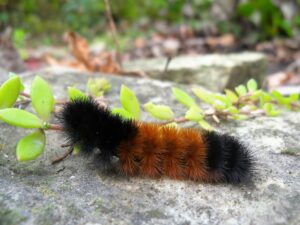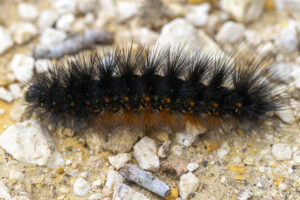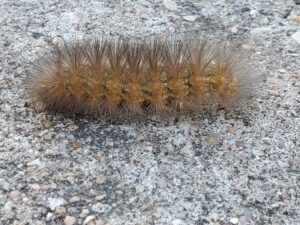- La Feria Community Holds Succesful Business Mixer Event
- Little Nashville to Take Place in Downtown Mercedes
- Lions Basketball Captures District Gold
- La Feria ISD Students Compete in Regional Chess Tournament
- Lions End First Half of 32-4A on a High Note
- La Feria ISD Held Another Successful Parent Conference
- Strong Appearance for Lions at Hidalgo Power Meet
- LFECHS Students Get to Meet Local Actress
- Students Participate in Marine Biology Camp
- Two LFECHS Students Qualify for All-State Band
What Is That Fuzzy Black Caterpillar?
- Updated: January 5, 2024
Woollybear Caterpillar Makes Its Seasonal Journey To Overwinter

If you’ve been watching your step, there’s a good chance you may have spotted some fuzzy black caterpillars inching their way across roads, sidewalks or yards over the past several weeks.
Woollybear caterpillars are common across the U.S. and include several species of caterpillars that transform into tiger moths. Texans may have particularly noticed saltmarsh caterpillars, Estigmene acrea, one species found throughout the state.
But, before they can transform into tiger moths, these caterpillars must make haste to find suitable locations to overwinter as mature larvae, said Wizzie Brown, Texas A&M AgriLife Extension Service integrated pest management specialist, Travis County. And they’re likely to capture plenty of attention on their way as their population reaches its height for the year.
Together, the seasonal population peak and mass movement have created a “weatherman” mystique around these caterpillars, much like the famous Punxsutawney groundhog. Unfortunately, they don’t actually predict how harsh winter will be.
Still, their movement and soft, fuzzy appearance might tempt anyone looking downward, especially children, to pick them up.
Here, Brown answers common questions about these insects and explains whether their presence should be a cause for concern.

What are woollybear caterpillars?
Woollybear is a term used for several species of caterpillars that are densely covered in hair, or setae. Two common species of woollybear caterpillars found in Texas are the saltmarsh caterpillar and the garden tiger moth caterpillar. The saltmarsh caterpillar ranges in color from black to brown to yellowish, while the garden tiger moth caterpillar has a fuzzy black top and brown bottom.
Both caterpillars are present throughout the year but more prevalent in the fall. They can reach high numbers at that point, and then they start to wander around, looking for places to overwinter. You may see them cross roads or sidewalks, where they tend to be more visible.
Saltmarsh caterpillars got their name from a type of grass they eat, but, like the garden tiger moth caterpillar, they have a huge range. From late summer to fall, the weeds they normally feed on start to die off, so they move into areas that are maintained or irrigated.
Are woollybear caterpillars poisonous?
Many people see the hairs on this caterpillar and automatically think, ‘Don’t touch that — I’m going to be stung.’ Fortunately, these are not stinging caterpillars, so you can handle them, and they won’t hurt you.
There are many different species of these woollybear caterpillars that look very similar. Their coloration can be slightly different — some are more of a creamy yellow, some are darker brown or black — but all of these are non-stinging caterpillars.
Still, if you aren’t 100% sure what an insect is, it’s best not to touch it with your bare hands. If you want to pick a caterpillar up, put on some gloves; that way, you’re safe if it is a stinging caterpillar.

Are woollybear caterpillars beneficial insects?
Every insect has beneficial aspects. People think about bees and butterflies as being our pollinators, but there are a lot more pollinators out there than we give credit to. These would definitely fit into that category as adults, as the moths feed on the nectar of flowers.
The caterpillars also fit into the food webs of other insects, arthropods and mammals. They can be helpful in that regard. Birds and bats are likely to feed more so on the adult moths than the caterpillars, because the caterpillars are so fuzzy.
To a kid, these caterpillars may be viewed as a potential pet. But, if they’re eating your vegetable garden, then they’ll probably be considered a pest. The larvae have chewing mouthparts and feed on the foliage of plants, which can cause damage.
The amount of damage is dependent upon the size of the larva. The larger the size, the more damage it’s going to cause.
How long do woollybear caterpillars live?
Their life cycle includes four life stages — egg, larva, pupa and adult — which, depending on environmental conditions, can last up to six months. Adults lay up to 1,200 eggs on plants.
Larvae go through several instars before pupation. An instar is the insect between molts. When it hatches out of the egg, that’s the first instar. It molts into the next one, and that’s the second instar. And, in each successive molt, they’re getting larger. Typically, they’re in the larval stage for about a month to a month and a half. Environmental conditions like food availability, moisture and temperature affect how long the larval stage lasts.
The pupal stage is typically going to be in leaf litter or soil. The caterpillars form a cocoon with silken hairs that they build around their body, and that usually lasts about two weeks.
During the winter, they’re not going to be as active. They may come out on warmer days, but they’ll overwinter in a nice, cozy area. They go into something like hibernation. For insects, it’s typically called diapause.

Are there more woollybear caterpillars this year?
I don’t think there are necessarily any more this year than any other year. Most people don’t look down on the ground for bugs, so it all depends on who’s paying attention.
They’re also found in clusters usually. They’re widespread over Texas, but there won’t be huge numbers everywhere.
What is behind the myth that woollybear caterpillars predict winter severity?
With the banded woollybear, there is a belief that the size of the brown band on the caterpillars versus the black will say how severe that winter will be. The larger the band, the more severe the winter.
The problem with that is, firstly, there are around eight different species of caterpillars called woollybear caterpillars, and not all of them are the same color. Secondly, the coloration can also depend upon what stage the caterpillar is in. If it’s in one of the smaller instars, the coloration or the size of the band will be slightly different than if you have the later stages. It can also depend on what they’ve been eating and how much food they’ve been getting. There’s a lot of stuff that goes into it.
So, while it’s an interesting wives’ tale, it doesn’t actually hold water.




